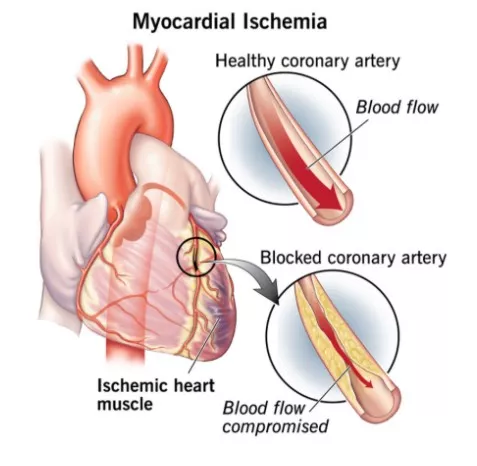A new global health study reveals a significant epidemiological shift in India, from infectious diseases to non-communicable diseases (NCDs) as the primary causes of death.
- Ischaemic heart disease has become the leading cause of mortality, signalling an urgent need to focus on healthy ageing and NCD prevention.
What is Ischaemic Heart Disease (IHD)

- Ischaemic Heart Disease also known as Coronary Artery Disease (CAD), occurs when the blood supply to the heart muscle (myocardium) is reduced or blocked due to the narrowing of coronary arteries by atherosclerosis (plaque buildup).
- This leads to an imbalance between oxygen supply and demand in heart tissues.
Causes
- Atherosclerosis: Deposition of cholesterol and fatty substances in arterial walls.
- Lifestyle Factors: Smoking, physical inactivity, unhealthy diet, obesity, and stress.
- Medical Conditions: Hypertension, diabetes mellitus, and high LDL cholesterol levels.
- Age & Genetic Predisposition: Common in older adults and those with a family history of heart disease.
|
Key Highlights of the Study
| The Age-Standardised Mortality Rate (ASMR) is a statistical measure that shows the mortality rate of a population adjusted for age distribution. |
Changing Disease Patterns in India
- From infections to NCDs: In 1990, diarrhoeal diseases led to deaths (ASMR: 300.53 per lakh).
- By 2023, ischaemic heart disease topped the list (ASMR: 127.82 per lakh).
- Other leading causes (2023):
- Chronic Obstructive Pulmonary Disease (COPD): ASMR 99.25 per lakh.
- Stroke: ASMR 92.88 per lakh.
- Covid-19’s decline: Once the leading cause in 2021, it fell to 20th place in 2023.
Life Expectancy and Mortality Trends
- All-Cause Mortality: Overall ASMR dropped from 1,513.05 per lakh in 1990 to 871.09 per lakh in 2023, reflecting improved healthcare and disease management.
- Overall Progress: India’s life expectancy rose from 58.46 years in 1990 to 71.56 years in 2023 — a 13-year increase.
- Gender Gap:
-
- Males: from 58.12 (1990) to 70.24 (2023)
- Females: from 58.91 (1990) to 72.96 (2023)
- This improvement indicates longer lifespans but higher morbidity, increasing the burden of chronic illnesses.
Oral Hygiene and Heart Health
A recent study published in the Journal of the American Heart Association, reveals that oral bacteria may play a direct role in triggering heart attacks.
Key Findings of the Study
- Bacterial Biofilms in Arteries: Researchers identified viridans streptococci, common oral bacteria inside atherosclerotic plaques in arteries. These bacteria form biofilms that remain hidden from immune detection until the plaque ruptures.
- Prevalence: In samples from 121 autopsies and 96 vascular surgery patients, bacterial DNA was found in a significant number, with viridans streptococci present in ~42% of both groups.
- Mechanism of Plaque Rupture: In ruptured plaques, bacteria migrated to surface layers and activated Toll-like Receptor 2 (TLR2) — triggering immune inflammation that may precipitate heart attacks.
- Antibiotic Resistance: The persistence of these biofilms explains why antibiotic treatments for heart disease have failed, as biofilm-embedded bacteria resist immune and drug action.
|
Global Burden of Disease (GBD) Report
- Initiated in 1990 by the World Health Organization (WHO) and the World Bank.
- Now led by the Institute for Health Metrics and Evaluation (IHME) at the University of Washington, USA.
- Key Indicators
- DALY (Disability-Adjusted Life Years): Measures total years of healthy life lost due to illness, disability, or premature death.
- YLL (Years of Life Lost): Premature deaths compared to life expectancy.
- YLD (Years Lived with Disability): Time spent in less than full health.
- The Latest Report was released in World Health Summit (WHS), Berlin, Germany.
World Health Summit (WHS), Berlin
- Founded in 2009 on the occasion of the 200th anniversary of the Charité – Universitätsmedizin Berlin, one of Europe’s oldest medical universities.
- Organized in collaboration with the World Health Organization (WHO) since 2019, giving it official global recognition.
- Attended by representatives from WHO, World Bank, UN agencies, governments, academia, private sector, and NGOs.
- India regularly participates through the Ministry of Health and Family Welfare and public health experts.
|
![]() 14 Oct 2025
14 Oct 2025


